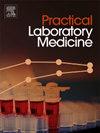Gene variant analysis in pediatrics with early-onset epilepsy: Identification of novel variants
IF 1.7
Q3 MEDICAL LABORATORY TECHNOLOGY
引用次数: 0
Abstract
Background
Epilepsy encompasses a range of brain disorders, often accompanied by growth delay and cerebral palsy. The identification of gene variants is critical for guiding treatment strategies in patients with epilepsy. This study investigates the genetic variants in patients with early-onset epilepsy (EOE) through whole-exome sequencing (WES).
Materials and methods
DNA was extracted from peripheral blood using a standard salting-out method. Gene variants were identified using WES, and sequencing data were analyzed through a two-step approach.
Results
Among 20 subjects, WES identified two novel variants. The first variant, AP3B2 (NM_001278512.2: c.3190G > A; p. Val1064Ile), was located in exon 27 and exhibited homozygosity in the proband and heterozygosity in the parents. The second variant, PIGB (NM_004855.5: c.1664G > C; p.Ter555Serext∗54), was located in exon 12 and demonstrated a similar inheritance pattern. Notably, the PIGB variant was associated with elevated ALP levels.
Conclusion
This study highlights the value of WES in identifying genetic variants associated with epilepsy, particularly the novel AP3B2 and PIGB variants. By focusing on these impactful findings, the study advances understanding of epilepsy genetics and emphasizes the role of WES in enabling early diagnosis, personalized treatment, and improved management strategies.
求助全文
约1分钟内获得全文
求助全文
来源期刊

Practical Laboratory Medicine
Health Professions-Radiological and Ultrasound Technology
CiteScore
3.50
自引率
0.00%
发文量
40
审稿时长
7 weeks
期刊介绍:
Practical Laboratory Medicine is a high-quality, peer-reviewed, international open-access journal publishing original research, new methods and critical evaluations, case reports and short papers in the fields of clinical chemistry and laboratory medicine. The objective of the journal is to provide practical information of immediate relevance to workers in clinical laboratories. The primary scope of the journal covers clinical chemistry, hematology, molecular biology and genetics relevant to laboratory medicine, microbiology, immunology, therapeutic drug monitoring and toxicology, laboratory management and informatics. We welcome papers which describe critical evaluations of biomarkers and their role in the diagnosis and treatment of clinically significant disease, validation of commercial and in-house IVD methods, method comparisons, interference reports, the development of new reagents and reference materials, reference range studies and regulatory compliance reports. Manuscripts describing the development of new methods applicable to laboratory medicine (including point-of-care testing) are particularly encouraged, even if preliminary or small scale.
 求助内容:
求助内容: 应助结果提醒方式:
应助结果提醒方式:


